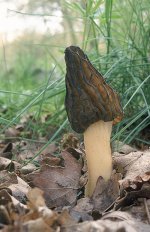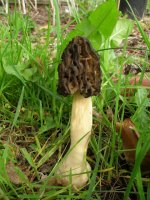I'm fairly sure that it is a Mitrophora semilibera, which is sometimes classed as a Morel. It is perhaps the most common of the Morel species, though the true Morels are in the Morchella genus.
I would be interested to know precisely when it was found, as the usual season is Spring, with April and May being the usual months, at least down here in Southern England. It is a fairly frequent species, though not common. It is rather variable. The brain like cap can be larger than the stem, or it can be tiny. I have eaten them, but I can't say they are worth bothering with.
Please note that there are deadly poisonous look-alikes so eating is not really advised unless you know what you are doing.
I have found them at the side of woodland paths, alongside canals, and in scrub vegetation on chalk soil. They seem to occur where people walk dogs, which kind of puts me off eating them anyway!
See here for a description and photos:
http://www.rogersmushrooms.com/gallery/DisplayBlock~bid~6464.asp
Leif









